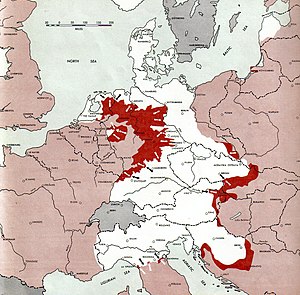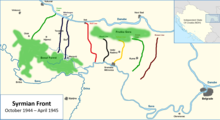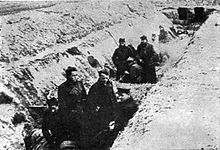Syrmian Front
| Syrmian Front | |||||||
|---|---|---|---|---|---|---|---|
| Part of theYugoslavandEasternfronts of theEuropean theatreofWorld War II | |||||||
 Syrmianfrontline (far south-east) as a part of the EuropeanEastern Frontin April 1945. | |||||||
| |||||||
| Belligerents | |||||||
|
Allies: (includingItalia Brigade) |
Axis: | ||||||
| Commanders and leaders | |||||||
|
|
| ||||||
| Casualties and losses | |||||||
|
(including | Total 30,000 killed[2] | ||||||
TheSyrmian Front(Serbo-Croatian:Srijemski front/Sremski front) was anAxisline of defense duringWorld War II.It was established as part of theEastern Frontin late October 1944 inSyrmiaand eastSlavonia,northwest ofBelgrade.
After theYugoslav Partisansand theRed Armyexpelled the Germans from Belgrade in theBelgrade Offensive,the retreatingWehrmachtand theCroatian Armed Forcesused fortifications to protect the withdrawal of GermanArmy Group Efrom theBalkans.With help from their Soviet allies, thePartisans(by then recognized as the Yugoslav army), joined byBulgarianandItalianforces, fought a difficult winter campaign and finally broke through the front on 12 April 1945.
After the Syrmian front was broken, occupied Yugoslavia was liberated.[3]
Operative background and significance[edit]
After the September advance through Romania and Bulgaria in October 1944, The Red Army, together with Yugoslav forces, took Belgrade (central communication node of theBalkans) in theBelgrade Offensive.Due to Yugoslav partisan activity,[4]the Yugoslav-AlliedOperation Ratweek,and pressure from the Bulgarian Army, the Germans failed to prevent this while they awaited the redeployment ofArmy Group Etroops from Greece. The Red Army decided to exploit this delay and continued to advance with the3rd Ukrainian FrontfromBelgradeto south-westHungary.The aim of the advance was to separate and protect their main attack in Hungary from attacks on the flank by Army Group E from the south.
From September 1944 to January 1945, Army Group E pushed its way throughMacedonia,Kosovo,Sanjak,andBosnia,and soon their sole available escape route was in a line betweenSarajevoandSlavonski Brod.For this reason, it was of vital significance for the Germans to defend the zone around Slavonski Brod, which was threatened by the Soviet-Yugoslav advance through Syrmia. To prevent Army Group E from being cut off, the German South-East command prepared seven successive fortified defense lines between theDanubeandSava riverfromRumatoVinkovci.The Syrmian Front campaign consisted of Yugoslavian attempts to break through these lines of defense.
Operations[edit]



The Syrmian Front saw some of the most difficult fighting inYugoslavia in World War II.It lasted for almost six months. As the bulk of the Red Army involved in the Belgrade operation continued theiroffensive in Hungary,the Yugoslav Army, accustomed toguerrilla warfarein the mountainous terrain of theDinaric Alps,remained to fight theentrenched front lineheavily contested by the Axis on the flat ground of thePannonian plain.[5]Young men fromVojvodinaandCentral Serbia,many from freshly liberated regions, were drafteden masseand sent to the front, and the amount of training they received and their casualty levels remain in dispute.[6]
Although mostly stationary, the front moved several times, generally westward, as the Axis forces were pushed back. The fighting started east ofRumaand stabilized in January 1945 west ofŠidafter the town changed hands due to Axis counterattacks. In late March and early April 1945, Yugoslav Army units mounted ageneral offensiveon all fronts. TheYugoslav First Army,commanded byPeko Dapčević,broke through GermanXXXIV Corpsdefenses in Syrmia on 12 April, quickly capturing the cities ofVukovar,Vinkovci,andŽupanja,and enabling further advances throughSlavoniatowardSlavonski BrodandZagrebin the last month of the war.
The campaign can be divided into four distinct phases:
- The first phase lasted from 24 October to the end of December 1944, and was characterized by slow but steady advancement of Yugoslav and Soviet forces through the seven German fortified lines of defense through fierce battles and heavy losses on both sides.[7]
- In the second phase, from 3 to 26 January 1945, the Germans performed a successful counterattack with the newly arrived forces ofXXXIV Corpsof Army Group E, and succeeded in winning back to the Nibelung Line, the main line of defense in Syrmia, while inflicting heavy losses to the Yugoslav Army.[8]
- The third phase was a stalemate period from 26 January to 12 April 1945. In this period both sides only performed limited reconnaissance activities.[9]
- The fourth phase began when Yugoslav forces broke through the German defense lines on 12 April, with heavy German losses and fierce battles and Army Group E retreating.[10]

References[edit]
- ^62nd Anniversary announcementArchived7 June 2011 at theWayback Machine,B92,2007.
- ^abStratište srpske mladosti,Vlada Arsić, 2008.(in Serbian)
- ^»Sremski front 1944–1945«, n. f. str. 42, 166, 200 i 285.
- ^Report of the Commander in Chief of the South-East to Army Headquarters, 20. September 1944, NAW T311, roll 191, frames 637–642
- ^Đilas 1977,p. 440.
- ^Pavlowitch 2008,p. 258.
- ^Ljubivoje Pajović, Dušan Uzelac, Milovan Dželebdžić: Sremski Front 1944–1945,BIGZ, Belgrade 1979, chapter II –Uspostavljanje Sremskog fronta i borbe u Sremu do kraja 1944.(in Serbian)
- ^Ljubivoje Pajović, Dušan Uzelac, Milovan Dželebdžić: Sremski Front 1944–1945,chapter V –Nemačke ofanzivne operacije na Sremskom frontu u januaru 1945.(in Serbian)
- ^Ljubivoje Pajović, Dušan Uzelac, Milovan Dželebdžić: Sremski Front 1944–1945,chapter VII –Period zatišja i priprema za prolećne ofanzivne operacije(in Serbian)
- ^Ljubivoje Pajović, Dušan Uzelac, Milovan Dželebdžić: Sremski Front 1944–1945,chapter XI –Plan proboja Sremske utvrđene zone,chapter XII –Prva armija u proboju utvrđene zoneand chapter XIV –Od Srema do Austrije(in Serbian)
Sources[edit]
- Đilas, Milovan (1977).Wartime.New York: Harcourt Brace Jovanovich.ISBN0-15-694712-9.
- Ljubivoje Pajović, Dušan Uzelac, Milovan Dželebdžić: Sremski Front 1944–1945,BIGZ, Belgrade 1979(in Serbian)
- Pavlowitch, S.K. (2008).Hitler's New Disorder: the Second World War in Yugoslavia.New York: Columbia University Press.ISBN978-0-231-70050-4.
Further reading[edit]
- Trifković, Gaj (2016)."Carnage in the Land of Three Rivers: The Syrmian Front 1944–1945".Militärgeschichtliche Zeitschrift.75(1): 94–122.doi:10.1515/mgzs-2016-0004.S2CID132224010.
- Trifković, Gaj (January 2018). "The Yugoslav Partisans' Lost Victories: Operations in Montenegro and Bosnia-Herzegovina, 1944–1945".The Journal of Military History.82(1): 95–124.ISSN0899-3718.
- Battles involving Bulgaria
- Battles of World War II involving Bulgaria
- Conflicts in 1944
- Conflicts in 1945
- Eastern European theatre of World War II
- Battles and operations of World War II
- Battles involving the Yugoslav Partisans
- Battles involving the Independent State of Croatia
- Military operations of World War II involving Germany
- Battles and operations of World War II involving Bulgaria
- Soviet Union–Yugoslavia relations
- 1944 in Yugoslavia
- 1945 in Yugoslavia
- History of Vojvodina
- History of Syrmia
- History of Slavonia
- Serbia in World War II
- Croatia in World War II
- Croatia–Serbia relations



